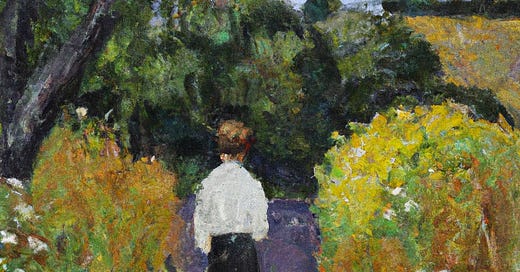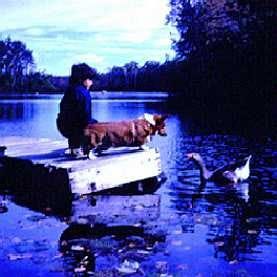I had a few ideas for things to write this week, and a couple of pieces that were already in draft form. But I’ve been so disgusted and exhausted by the gleeful recklessness and cruelty of our government that I didn’t have the heart to finish anything. None of it seemed to matter, or none of it felt like anything I had a right to be opining about. So, here’s something a little gentler and more personal that I posted a while ago.
When I’m in the right frame of mind, any dirt road I’m on becomes the first dirt road I ever walked—a quiet, residential byway that snaked along Stockbridge Bowl in the Berkshire mountains of western Massachusetts. Wherever I happen to be, if it’s quiet enough to hear pebbles crunch under my feet and a breeze blow through the weeds, my mind takes me back to my original happy place, meandering along the quiet, one-lane road that connected summer homes in a development called Lake Drive.
In the late 1960s and early 1970s, when I was a child, the skinny tail of Stockbridge Bowl that led to a waterfall was bounded on both sides by cottages. The side called Beachwood was more built-up and populous; the side we were on, which didn’t even have a name when we moved there, was more sparsely populated, especially as you moved out of the woods and into the open air. There were fewer houses there, closer to the waterfall; newer, bigger, more modern. The road seemed to change, too, perhaps from more exposure to sunlight. The rocks and pebbles seemed whiter and cleaner, and the crunch under my feet felt different. Down where we lived, the woods were denser and the cottages seemed smaller and older.
Lake Drive started on Route 183—just an unmarked turnoff back in the day, and then, later, marked only with a small sign. Even today, the entrance is unassuming. Driving down the dirt road towards the woods, you curve past a field of tall weeds, unsure what the purpose of this road might be. It isn’t until you enter a cave of dense trees that you can see that people live here.
The cottages, deep in the shade of the woods, were an idiosyncratic lot back then; no two looked the same. Some had lawns; most simply lived nestled in the woods. Most looked hand-made. Some were. I remember watching a neighbor build his own house. I would occasionally run back and forth for him to bring him tools. He rewarded me by placing an acorn I had given him up on the roof as part of the chimney.
Our house was tiny—a single story, with an open living room/dining room plan, one bathroom, and three small bedrooms. It was non-functional in winter weather, so we boarded it up at Labor Day, drained the pipes, and left it behind for the bulk of the year.
In front of the house was a large patch of dirt that refused to turn into a lawn, with a rapidly rusting swing set. Halfway down the front yard, there was a a pathway cutting through the woods down to the dock where I could sit with my dog, communing with local ducks and geese.
We had an old rowboat, which was mine to take out whenever I wanted, once I knew how to row it. Sometimes, I tied up at a small island and pretended to be Tom Sawyer. Mostly, I just liked to row out into the middle of the lake and drift, reading a book and dreaming my dreams.
I wandered a lot during those childhood summers, totally unsupervised. I don’t think my parents ever knew where I was, and I don’t think they ever worried about the fact that they didn’t know, as long as I was back by nightfall. We had two acres of woods around and behind the cottage, and they were mine to explore. There were giant, limestone boulders strewn about, that I could scamper up like a goat, grabbing handfuls of moss to help haul myself to the top. Some were quite tall; one, behind our cottage, was as high as the house. I liked to find long, thick tree limbs on the ground (long to me, at least), and use them to lever myself off the tops of big rocks, swinging through the air and crashing down into the leaves below. It’s a good thing I never broke a leg, because it would have been hours before anyone knew I was in trouble.
And I walked. I walked up the road, out of the cave of trees, to have private little picnics in the field of weeds, opening milkweed pods and playing with the maple tree seeds that had helicopter-rotor wings on them. I walked down the road, along the lake outlet, passing my hands along the flat tops of queen anne’s lace and listening to the rhythmic crunch of my feet on the sand and pebbles. I walked to the waterfall and over the little, wooden bridge that finally, at lake’s end, connected Lake Drive to Beachwood. And then I walked back, humming made-up songs about weeping willow trees.
So much time alone with my thoughts and dreams and songs, with nothing but wind and birdsong to accompany me. How could I have known how rare that time and that silence would become?
Last week, we went down to Cape May, in New Jersey, with my wife’s family, for our annual time at the beach (sorry—the shore). There were 11 of us in the house, spanning three generations. It was happy and fun, but it was loud. One day, I rode my rental bike out to the state park and walked along the nature trail. Each morning, I’d been running along the boardwalk with the usual music or podcast voices in my ears, and it was always a nice respite—but this day, I rode without headphones and then walked in silence.
The nature trail has a long expanse of handsome, raised, wooden walkways, but deeper into the woods, the walkways disappear and turn into paths of dirt and then, closer to the water, pebbles and shells. And as I walked alone, with no electronic noise in my head, I heard my feet crunching rhythmically on the road below my feet, and I was home again—picking queen anne’s lace and singing to the trees.
It requires some silence, which is harder and harder to find, and harder to grant ourselves even when the environment allows it. It requires some silence and some time to let the world recede a little, to let your brain stop reacting to the constant stimuli of life. The world is too much with us, as Wordsworth says. Sometimes we have to get away from the world we’ve made and touch the earth we didn’t make, to remind ourselves where we really live.
It’s not merely a dirt road that sends me back into my childhood; it’s a dirt road and a long stretch of silence—long enough to let that rhythmic crunching lull me into a sort of trance so that I can let the balloon string go and allow my mind to float and wander where it will. I keep that brain on a tight leash too much of the time. It’s nice to unclip it and let it run free. I wish I remembered, more often, to do that.
I was lucky to have those woods when I was a child. I was more than lucky; I was privileged. We need to protect the wild spaces we have—especially our public, wild spaces, so that everyone can have access. But we also need to protect our souls when we’re in those spaces, by pausing the constant bombardment of words and music, just for a bit. More than a bit, actually. It takes some time for the roar to recede and for anything else to have a chance.
Will it seem boring? It might seem boring, especially if we’re not used to it. But maybe we should give ourselves the gift of occasional boredom in this world of constant stimulation. Take a walk without purpose or goal, listening only to the world around you. Do it until you get antsy, and then do it a little longer, letting your mind sink deep into yourself and, at the same time, fly free.
I know where my thoughts like to go. Where do yours take you?





